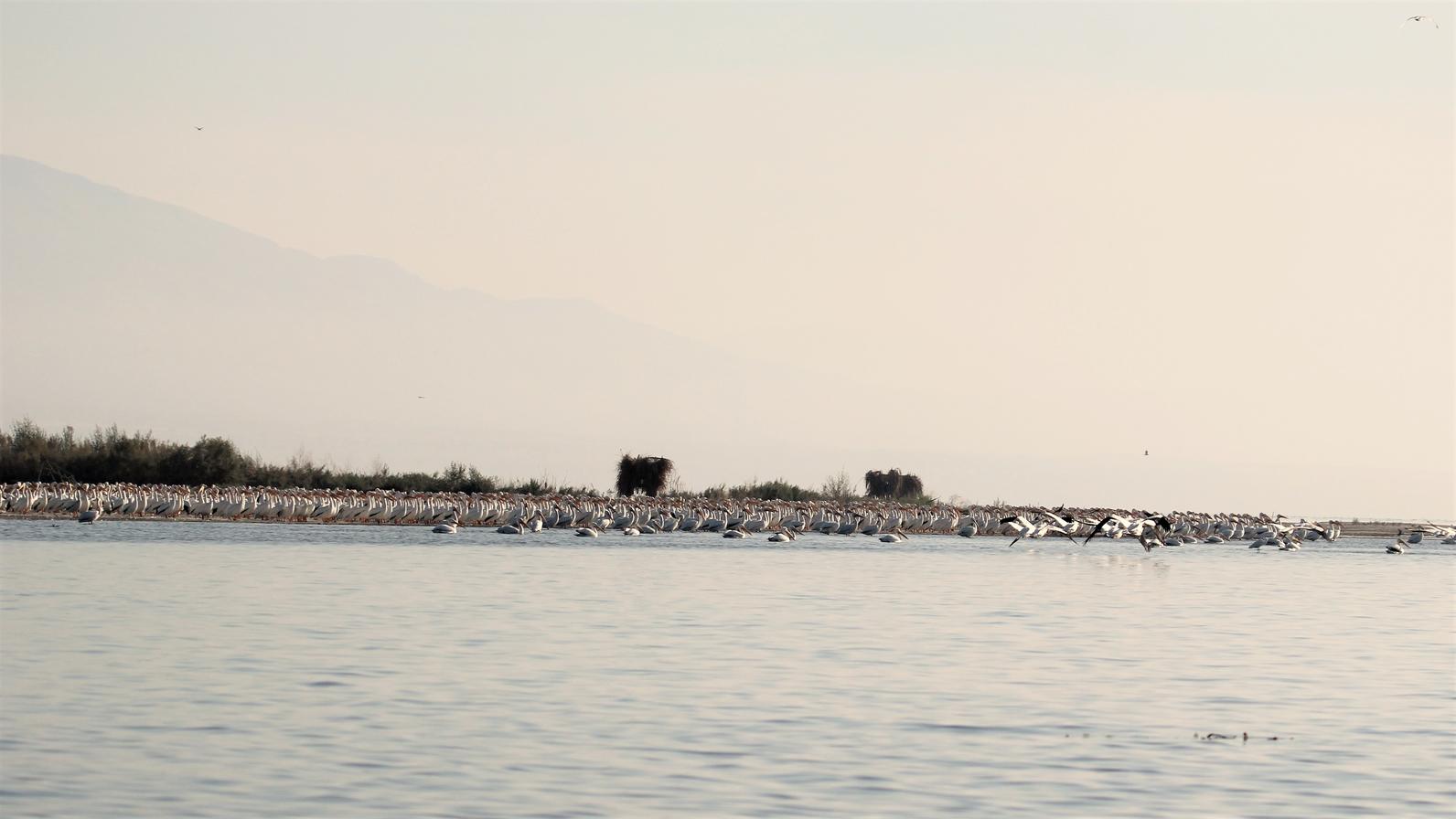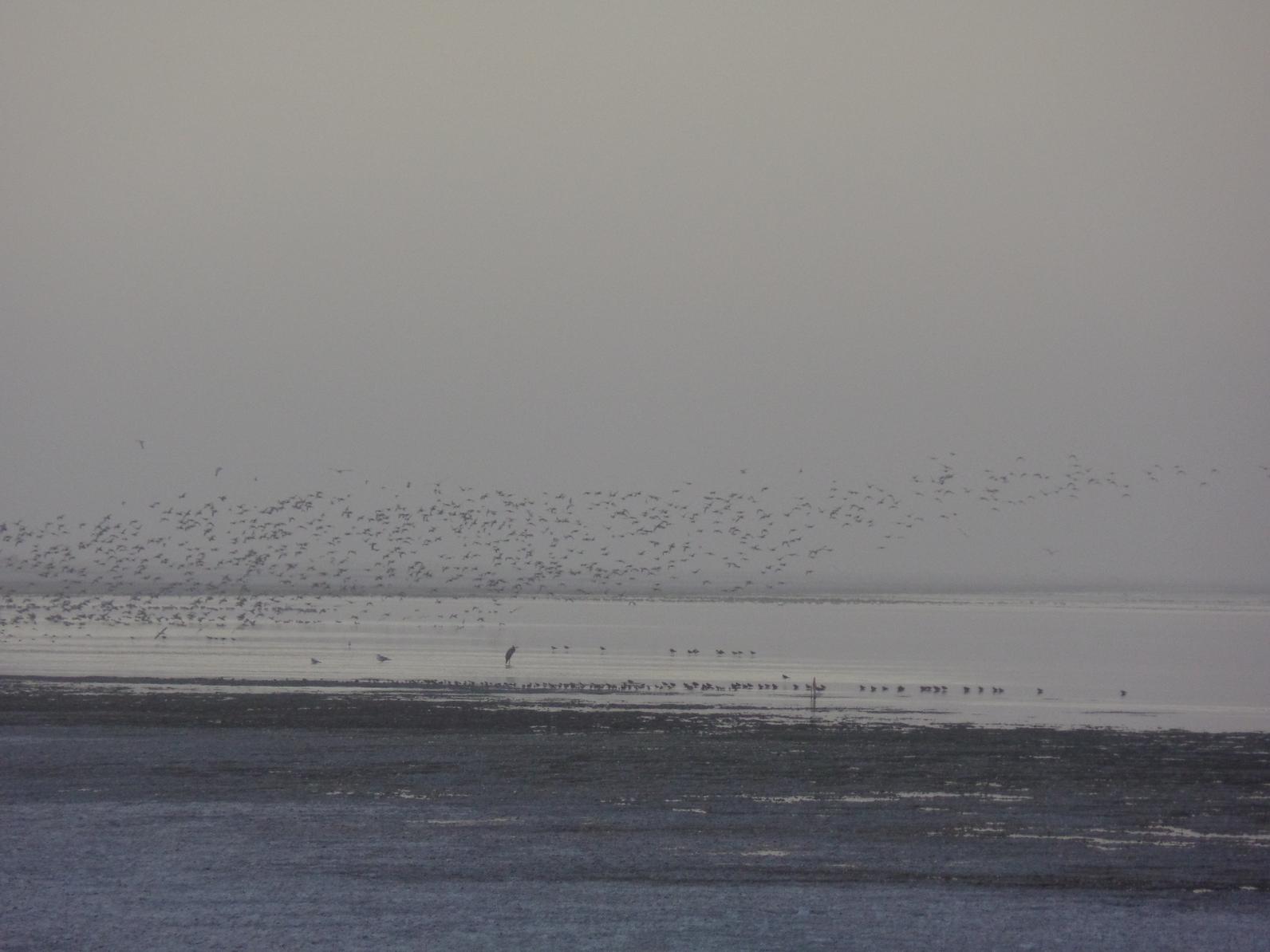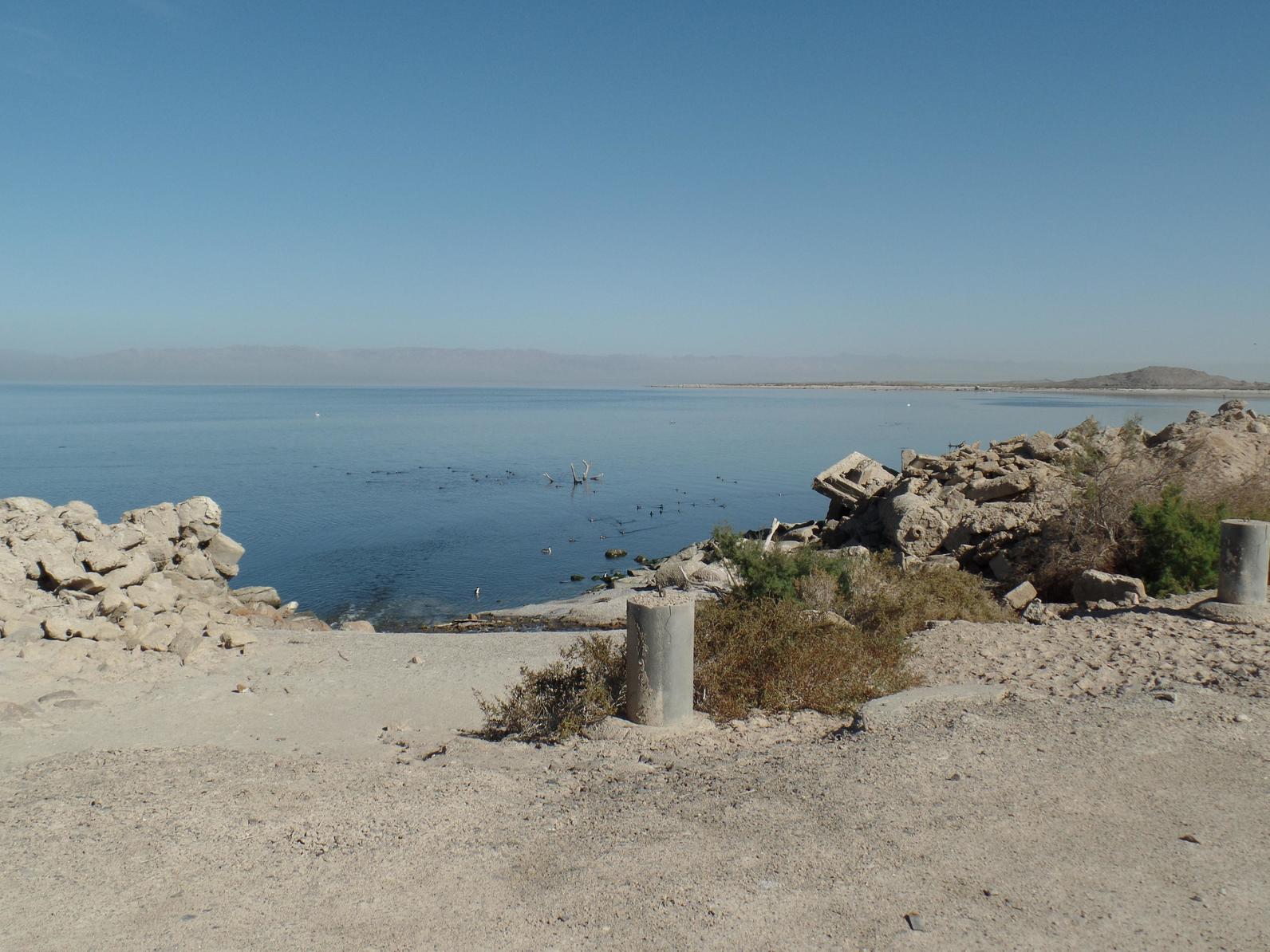
When’s the last time you were at the Salton Sea?
If it’s been more than a year or so, things have changed. Some of the changes are physical and obvious – the shoreline is retreating, a few feet in some places, hundreds of yards elsewhere. Did you stop for shorebirds along Garst Road on the way to Red Hill, or search for Yellow-footed Gulls from your air-conditioned car at Obsidian Butte? Maybe you stopped for a drink at the store at Johnson’s Landing, and marveled at the pelicans offshore.
The retreat of shoreline in the past couple years has been the most noticeable change. Johnson’s Landing is still there in Salton City, but the water is a long way off, and you might not see many pelicans. Garst Road, which skirted Red Hill Bay, now passes a dry saltpan, with stick nests of Great Blue Herons marooned in distant, sun-bleached trees. Obsidian Butte is still there, but even with a scope it’s too far to look for gulls without walking.
What effect is this having on the birds? Of course, it’s complicated. American White Pelicans, to pick one, still flock to the sea, but the thousands of individuals thought to overwinter here – around 18,000 were estimated on waterfowl counts as recently as 2009 – are facing a saltier sea, with limited reproduction of their main food source, tilapia. Yet, they’re still using the sea, as of this past winter – Bob McKernan, the retired Director of the San Bernardino County Museum who birds the sea several times per month, sent me a photo from November 2016 showing at least a thousand white pelicans lined up at a shoreline roost at the north end. The sea may not be dying – but it is changing.
A few weeks ago, I joined San Bernardino Valley Audubon Society on their annual North End Salton Sea Christmas Bird Count (CBC), organized by Chet McGaugh. Our group, which included Steve Umland, visiting from the central Sierra Nevada, and Phil Parker, a Palm Springs local, was assigned a stretch of the northeastern shoreline between the town of Mecca and the State Recreation Area. I’d birded this area for many years and knew the right farm roads to follow and which gates were usually open. We couldn’t even make it to the shoreline at our first stop, our way blocked by a dense thicket of tall tamarisk that has invaded as the water level of the sea dropped. Eventually we located a path, probably hacked by duck-hunters earlier in the fall, marked with red bits of flagging. As we sloshed across the barnacle and fish-bone beach, past bands of drying dead tilapia, we were soon on the muddy edge of the sea, and so were the birds – flocks of dowitchers and other shorebirds frantically feeding in drying pools, Snowy and Semipalmated plovers darting over drier spots, plus the gulls, pelicans, ducks, and other species that would have relied on the local ecosystem for millennia, as the Salton Trough has repeatedly filled with water and drained.

But what I’ve noticed most on recent months’ trips to the sea has been the lack of birds out in the open water of the sea – the dearth of ducks and grebes – the species richness is still there, the numbers are just low. Scoping up and down the beach were a few dozen gulls and the occasional pod of a half-dozen or so American White Pelicans, but not the numbers of past years – at least not what I remember.
The trouble with Eared Grebe is that the Salton Sea is a key “staging” area for the species, with large groups stopping over here on their way north after wintering in Mexico. Though the species occurs across Europe and Asia, its entire North American breeding range is limited to the marshy ponds of the Great Basin, and after nesting, the population shifts to a small number of saline lakes of the interior West, after which birds make their way south and west, including down the Pacific Coast of Mexico. Birds also can raft by the thousands – or did so until recent years – on the Salton Sea for the winter.
But this appears to be changing too. Chris Schoneman, Project Leader for the Sonny Bono Salton Sea National Wildlife Refuge at the south end of the sea, notes: “this past spring during April and May when we had lots of windy days, the SE corner of the Sea got very wavy and was washing a lot of dead tilapia to shore. All adult fish approximately 7-8" long. No new/young fish. Along with that we were seeing very weak and sometimes dead eared grebes washing ashore. Emaciated. Wildlife disease expert analysis indicated they died from starvation.” It’s worth noting that our local Eared Grebes eat invertebrates (pile worms), not fish, so it’s likely that various components of the sea’s ecosystem were struggling last spring.
Of course, dead fish, and more than the occasional dead bird, are nothing new for the Salton Sea, like any harsh environment that supports huge numbers of wildlife. Chris continued, with a more troubling observation, “At the same time the beaches from the Alamo River south to the New River [at the southeastern corner of the sea] were almost vacant of birdlife. The beach adjacent to our Rock Hill Trail between Rock Hill and Obsidian Butte, which normally has hundreds if not thousands of waterbirds had about six per day for about two weeks. As the weeks passed birds returned. But this was the first time we had seen this dramatic of a departure of birds from this part of the Sea. To us it was different and perhaps an indicator of a changing Salton Sea.”
Audubon’s Christmas Bird Count is a fairly low-tech means of estimating the total population of just about anything, anywhere, since it only covers a fraction of the habitat, and lasts only for one day a year – that said, these late December counts of Eared Grebes have averaged 10,000 to15,000 birds since the mid-1980s, and this year found a fraction of that number (exact total still being tallied). Indeed, when I was out surveying birds near the southeastern corner of the sea with Audubon California Director of Bird Conservation Andrea Jones this past November, we marveled at the thousands of birds, ducks, shorebirds, pelicans, massed around the shallow water of the Rock Hill area west of the refuge headquarters, as if there was some burst of a food source happening there, and all the birds in the sea had taken notice and piled in. But the only place where we saw Eared (and Western) Grebes, and numbers of Ruddy Duck, was around the end of a small agricultural drain where fresh water was gushing out into the sea.
But is all change necessarily bad? A few weeks ago, a casual count of Eared Grebe at Lake Havasu on the lower Colorado River reached 60,000+ birds in late December, matching prior high counts in 2014. These may have been birds that would have stopped at the sea, and it’s worth noting that conservationists tend to consider the lower Colorado part of the same ecosystem – in many ways, the river and the Salton Sea function as one big delta; but the lower Colorado River is arguably just as imperiled as the Salton Sea, particularly given recent catastrophic droughts across the West, and ongoing demands for its water.

It does appear the Eared Grebe is shifting its distribution, changing when it appears at the Salton Sea. Recent high counts here have come not in winter, but in April, of birds in high breeding plumage staging on the sea, prior to flying northeast to nest. Even American White Pelican may not be actually declining – yet – they may simply be more concentrated into smaller areas where food is concentrated, such as at the mouths of freshwater drains into the sea. Bob McKernan wrote that the seawide high counts of white pelicans in the 1980s were similar to two recent winters (2014-16) in the same subsections of the shoreline; however, these observations are preliminary and should not be taken as evidence that all is well.
Perspective is important though, and even long-time birders are surprised by the sea’s resilience. Chet McGaugh, the North End CBC compiler who has birded the sea on more than 1000 visits over nearly 40 years, including 80 trips there in 2016, wrote that as he was leaving Unit 1 of the National Wildlife Refuge north of Westmorland at dusk on January 7 of this year, a flight of around 100,000 ducks passed overhead “for several minutes, never seen anything like it!!!” These were presumably Northern Shoveler and Northern Pintail moving from foraging areas at the edge of the sea to roost in flooded fields or impoundments somewhere in the Imperial Valley.
Recent proposals for restoration are largely focused on creating shallow-water wetlands across large areas where the receding sea has exposed alkali sediments (which blow as dust clouds and threaten human health as far away as Palm Springs). At least one pilot project under construction near Red Hill seeks simply to flood the playa with a few inches of fresh water. Tom Anderson, Assistant Manager at the nearby Sonny Bono Salton Sea National Wildlife Refuge, writes that such “low-impact” restoration designs will result in “a lot of natural habitat creation and food production resulting from freshwater flowing over newly exposed playa. The resulting habitat will be unmanaged but will be able to support many species…if so there is hope that most functions the Sea provides to migratory birds will be maintained.”

And maybe the biggest challenge of the Salton Sea is much simpler, and doesn’t involve nutrient loads or salinity. It’s to keep it a productive place for a huge variety of birds – and a destination that still brings people from all over the planet to marvel at its strangeness and unique beauty. Kurt Leuchner, a birder and local college instructor who also first visited the sea almost 40 years ago and who leads students and private clients here year-round, summed up his thoughts, “I've been teaching at the College of the Desert for over 20 years and all of my Conservation of Natural Resources students visit the Sea to learn about the ecosystem. Most of our students grew up in the Coachella Valley and the vast majority of them have never even visited the nearby Sea and have a very warped view of it. I try to correct this by dispelling the myths and actually taking them there and showing them what an important and beautiful ecosystem it actually is.”
The more time I spend at the sea (I first visited around 1983 on a family trip when I was a little kid with an old pair of opera glasses for binoculars!), I agree it’s going to take getting people to make a personal connection with a place, and helping them see the Salton Sea for what it is: a big ecosystem that an incredible abundance of wildlife depends on throughout the year.
Daniel S. Cooper is the founder of Cooper Ecological Monitoring, Inc.
By Daniel S. Cooper
Monthly Giving
Our monthly giving program offers the peace of mind that you’re doing your part every day.




